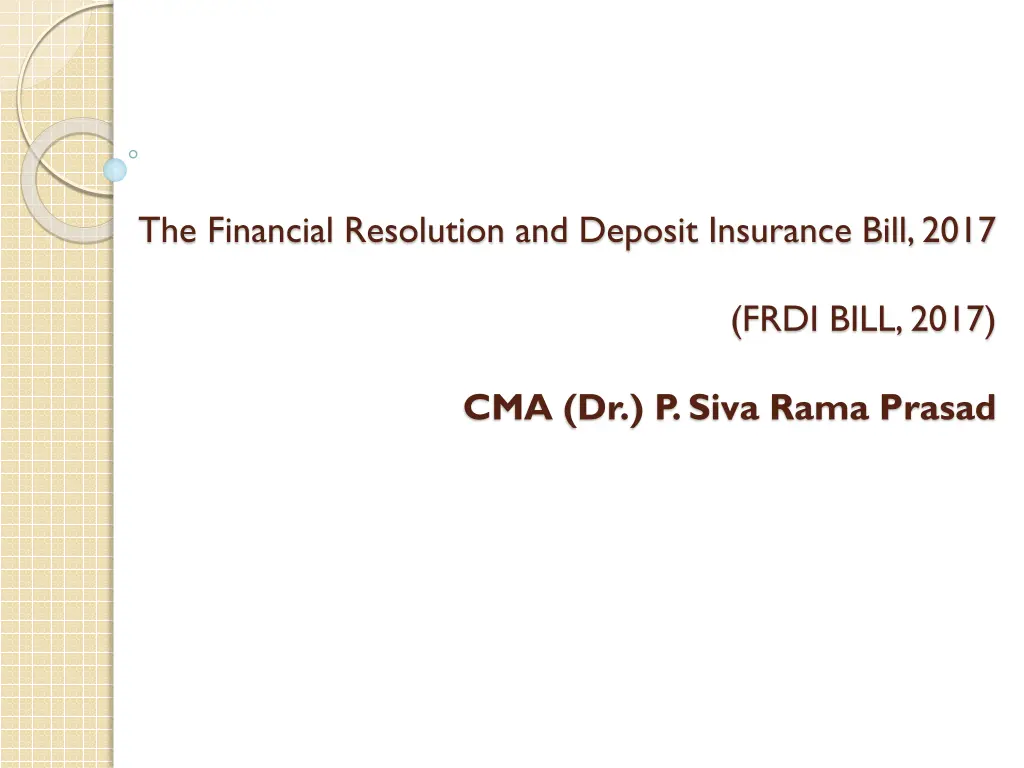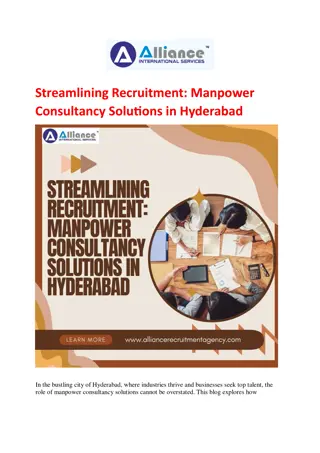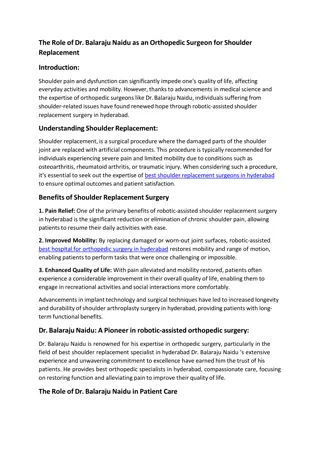
Financial Resolution and Deposit Insurance Bill 2017 Overview
Explore key aspects of the Financial Resolution and Deposit Insurance Bill 2017, covering its significance in India's financial system, distribution of financial assets, deposit insurance coverage, service providers, and entities covered by the bill.
Download Presentation

Please find below an Image/Link to download the presentation.
The content on the website is provided AS IS for your information and personal use only. It may not be sold, licensed, or shared on other websites without obtaining consent from the author. If you encounter any issues during the download, it is possible that the publisher has removed the file from their server.
You are allowed to download the files provided on this website for personal or commercial use, subject to the condition that they are used lawfully. All files are the property of their respective owners.
The content on the website is provided AS IS for your information and personal use only. It may not be sold, licensed, or shared on other websites without obtaining consent from the author.
E N D
Presentation Transcript
The Financial Resolution and Deposit Insurance Bill, 2017 (FRDI BILL, 2017) CMA (Dr.) P. Siva Rama Prasad
The Financial Resolution and Deposit Insurance Bill, 2017 (FRDI BILL, 2017) FINANCIAL SYSTEM IN INDIA
The Financial Resolution and Deposit Insurance Bill, 2017 (FRDI BILL, 2017) Distribution of Financial Assets in India (Source: Report of the Working Group on Resolution Regime for Financial Institutions)
The Financial Resolution and Deposit Insurance Bill, 2017 (FRDI BILL, 2017) High stake in distribution of Financial Assets in India is Banks i.e., 63% and their portfolio of deposits as on 31stMarch,2016 is as follows: In India out of the term deposits a/cs, 67% of the total Term Deposit A/cs are of less than Rs.1 lakh, who holds only 8.6% of the Term Deposit in terms of value. Thus, even if any banks every hypothetically fail, then it would not affect the small depositors at all, as it covered through DICGC.
The Financial Resolution and Deposit Insurance Bill, 2017 (FRDI BILL, 2017) Data on Cross Country Deposit insurance Coverage limit shows that Deposit insurance coverage in India is one of the lowest at Rs.1 lakh / $1,508 / 0.9 times India s per capital income. In India Bank failure is almost non-existent and till now the claims from DICGC is very few. Mostly,such claims have been raised only due to failure of few Co-operative Banks.
The Financial Resolution and Deposit Insurance Bill, 2017 (FRDI BILL, 2017) SERVICE PROVIDERS COVERED FRIDI BILL, 2017
The Financial Resolution and Deposit Insurance Bill, 2017 (FRDI BILL, 2017) The Bill will apply to Banks Insurance Companies Stock Exchanges Depositories Payment systems Non-banking financial companies and their parent companies. The central government may notify any other entities or funds to be covered under the Bill.
The Financial Resolution and Deposit Insurance Bill, 2017 (FRDI BILL, 2017) Definition of Banking "Banking" means the banking as defined in clause (b) of section 5 of the Banking RegulationAct,1949; "Banking institution" means a banking company as defined in clause (c) of section 5 of the Banking Regulation Act, 1949 and includes- A corresponding new bank as defined in clause (da) of section 5 of the Banking RegulationAct,1949; (ii) An eligible co-operative bank; (i)
The Financial Resolution and Deposit Insurance Bill, 2017 (FRDI BILL, 2017) Definition of Banking (Contd ..) (iii) A multi-state co-operative bank as defined in clause (cciiia) of section 56 of the Banking RegulationAct,1949; (iv) A Regional Rural Bank established under sub-section (1) of section 3 of the Regional Rural BanksAct,1976;and (v) The State Bank of India constituted under sub-section (1) of section 3 of the State Bank of India Act, 1955 and its subsidiary banks as defined in clause (nd) of section 5 of the Banking RegulationAct,1949; "Bridge service provider" means a company limited by shares, created by the Corporation under section 50.
The Financial Resolution and Deposit Insurance Bill, 2017 (FRDI BILL, 2017) Important Provisions Systemically important financial institutions (SIFIs): The central government may designate a financial firm as a SIFI. This would include financial firms whose failures may have a significant impact on the stability of the financial system.
The Financial Resolution and Deposit Insurance Bill, 2017 (FRDI BILL, 2017) Whether all NBFCs shall be governed by the provisions of FRDI Bill? The term covered service provider includes an NBFC, whether all NBFCs shall be governed by the provisions of FRDI Bill ? Out of 12,000 odd NBFCs, only 209 are Systemically Important NBFCs.
The Financial Resolution and Deposit Insurance Bill, 2017 (FRDI BILL, 2017) ABOUT FRDI BILL, 2017
The Financial Resolution and Deposit Insurance Bill, 2017 (FRDI BILL, 2017) Introduction In Budget Speech 2016 -17,the Finance Minister had announced: A systemic vacuum exists with regard to bankruptcy situations in financial firms. A comprehensive Code on Resolution of Financial Firms will be introduced as a Bill in the Parliament during 2016-17.This Code will provide a specialized resolution bankruptcy situations in Banks, Insurance Financial Sector Entities. mechanism to deal with and Companies This Code, together with the Insolvency and Bankruptcy Code 2016, when enacted, will provide a comprehensive resolution mechanism for our economy.
The Financial Resolution and Deposit Insurance Bill, 2017 (FRDI BILL, 2017) Financial Resolution and Deposit Insurance (FRDI) Bill,2017 is similar to the Insolvency and Bankruptcy Code,2016. FRDI deals only with the companies that are in the financial sector entities such as Banks and Insurance Companies etc. The insolvency code Act deals with companies in all other sectors (Non-financial institutions). Purpose of the Bill is to create a resolution regime for financial institutions when they face crisis without creating financial burden for the tax payers.
The Financial Resolution and Deposit Insurance Bill, 2017 (FRDI BILL, 2017) The Bill was referred to a Joint Committee of Parliament (Chair:Mr.BhupenderYadav) onAugust 10,2017. The committee consists of members from various regulators like RBI, SEBI, IRDA, PFRDA to submit a Bill on resolution of financial firms. The Committee submitted a draft Bill named as The Financial Resolution and Deposit Insurance (FRDI) Bill .
The Financial Resolution and Deposit Insurance Bill, 2017 (FRDI BILL, 2017) Preamble of the Bill A BILL to provide for the resolution of certain categories of financial service providers in distress; The deposit insurance to consumers of certain categories of financial services; designation of systemically important financial institutions;and Establishment of a Resolution Corporation for protection of consumers of specified service providers and of public funds for ensuring the stability and resilience of the financial system and for matters connected therewith or incidental thereto.
The Financial Resolution and Deposit Insurance Bill, 2017 (FRDI BILL, 2017) Key Objectives and Features of the Bill The Bill establishes a Resolution Corporation to monitor financial firms, anticipate risk of failure, take corrective action,and resolve them in case of such failure. The Corporate will also provide deposit insurance upto a certain limit,in case of bank failure.
The Financial Resolution and Deposit Insurance Bill, 2017 (FRDI BILL, 2017) Key Objectives and Features of the Bill The Resolution Corporation or the appropriate financial sector regulator may classify financial firms under Five Categories,based on their risk of failure. These categories in the order of increasing risk are: Low Moderate Material Imminent and Critical
The Financial Resolution and Deposit Insurance Bill, 2017 (FRDI BILL, 2017) RISK CATEGORISATION OF SERVICE PROVIDERS FRDI BILL, 2017
The Financial Resolution and Deposit Insurance Bill, 2017 (FRDI BILL, 2017) Details of Risk based Classification The Board in consultation with the Appropriate Regulator has been empowered to classify the covered service provider into five categories of risk to viability viz.,Low,Moderate,Material,Imminent and Critical.
The Financial Resolution and Deposit Insurance Bill, 2017 (FRDI BILL, 2017) Details of Risk based Classification (Contd ..) Such classification shall be made after taking into consideration the Adequacy of capital Assets and liability Asset quality Capability of management Earnings sufficiency
The Financial Resolution and Deposit Insurance Bill, 2017 (FRDI BILL, 2017) Details of Risk based Classification (Contd ..) Leverage ratio Liquidity of the covered service provider Sensitivity of the covered service provider to adverse market conditions; Compliance with applicable laws; Risk of failure of a holding company of a covered service provider or a connected body corporate in India or abroad.
The Financial Resolution and Deposit Insurance Bill, 2017 (FRDI BILL, 2017) The five stages of risk to viability framework: 1stStage Low risk to viability - The probability of failure of a covered service provider is substantially below the acceptable probability of failure.
The Financial Resolution and Deposit Insurance Bill, 2017 (FRDI BILL, 2017) The five stages of risk to viability framework: 2ndStage Moderate risk to viability - The probability of failure of a covered service provider is marginally below or equal to acceptable probability of failure.
The Financial Resolution and Deposit Insurance Bill, 2017 (FRDI BILL, 2017) The five stages of risk to viability framework: Low and moderate risk to viability - Resolution Corporation shall not have power to investigate or enter the premises and call for information / documents unless the covered service provider has been classified as imminent or critical. However, SIFIs are required to submit the Resolution Plan and Restoration Plan irrespective of the risk of viability. Also,such companies can be jointly inspected by the Resolution Corporation Authority (Regulator). and the Appropriate
The Financial Resolution and Deposit Insurance Bill, 2017 (FRDI BILL, 2017) The five stages of risk to viability framework: 3rdStage Material risk to viability - The probability of failure of a covered service provider is marginally above acceptable probability of failure.
The Financial Resolution and Deposit Insurance Bill, 2017 (FRDI BILL, 2017) The five stages of risk to viability framework: 3rdStage (Contd..) If a covered service provider has been classified as material risk to viability , resolution plan and restoration plan to Resolution Corporation and Appropriate Authority, respectively, within thirty days of such classification. such entity shall submit a
The Financial Resolution and Deposit Insurance Bill, 2017 (FRDI BILL, 2017) The five stages of risk to viability framework: 3rdStage (Contd..) If the covered service provider has been classified as material risk to viability by the Appropriate Regulator, and if the Board has difference in the opinion, then the Board shall record its reason in writing and convey the same to the Appropriate Regulator. Also, the Board may conduct independent inspection, if it continues to hold a different view.
The Financial Resolution and Deposit Insurance Bill, 2017 (FRDI BILL, 2017) The five stages of risk to viability framework: 4thStage Imminent risk to viability - The probability of failure of a covered service provider is substantially above the acceptable probability of failure.
The Financial Resolution and Deposit Insurance Bill, 2017 (FRDI BILL, 2017) The five stages of risk to viability framework: 4thStage (Contd..) The Resolution Corporation has been vested with the power to classify in the category of imminent risk to ability, if the covered service provider fails to submit a Resolution Plan to the Corporation after being ordered to so or it is determined that there has been fraud in the business of the covered service provider.
The Financial Resolution and Deposit Insurance Bill, 2017 (FRDI BILL, 2017) The five stages of risk to viability framework: 4thStage (Contd..) The Appropriate Authority as well as the Resolution Corporation has power to classify the covered service provider into this category; however, in case of central counterparties, only an Appropriate Authority has been authorized to classify into fourth stage of categories.
The Financial Resolution and Deposit Insurance Bill, 2017 (FRDI BILL, 2017) The five stages of risk to viability framework: 5thStage Critical risk to viability - The probability of failure of a covered service provider is substantially above the acceptable probability of failure.
The Financial Resolution and Deposit Insurance Bill, 2017 (FRDI BILL, 2017) The five stages of risk to viability framework: 5thStage On being classified as Critical risk to viability, the procedure for resolution shall commence and the Corporation shall be deemed to be a receiver of such covered service provider.
The Financial Resolution and Deposit Insurance Bill, 2017 (FRDI BILL, 2017) Key Objectives and Features of the Bill The management of a financial firm once it is classified as Critical . Resolution Corporation will take over the It will resolve the firm within one year (may be extended by another year).
The Financial Resolution and Deposit Insurance Bill, 2017 (FRDI BILL, 2017) Monitoring and Resolution of Financial Firms The Corporation and regulators will monitor financial firms based on their risk of failure. As this risk increases above acceptable levels (under categories), the Corporation or the regulator may direct the firm to take certain actions to mitigate risk of failure. material or imminent
The Financial Resolution and Deposit Insurance Bill, 2017 (FRDI BILL, 2017) Monitoring and Resolution of Financial Firms (Source: The Financial Resolution and Deposit Insurance Bill, 2017)
The Financial Resolution and Deposit Insurance Bill, 2017 (FRDI BILL, 2017) Key Objectives and Features of the Bill Resolution may be undertaken using methods including: Merger orAcquisition Transferring the Assets, Liabilities and Management to a temporary firm,or Liquidation If resolution is not completed with a maximum period of two years, the firm will be liquidated. The Bill also specifies the order of distributing liquidation proceeds.
The Financial Resolution and Deposit Insurance Bill, 2017 (FRDI BILL, 2017) "Bridge service provider" means a company limited by shares,created by the Corporation under section 50.
The Financial Resolution and Deposit Insurance Bill, 2017 (FRDI BILL, 2017) Monitoring and Resolution of Financial Firms (Contd..) These include: Preventing the firm from accepting deposits, Prohibiting it from acquiring other businesses, or Increasing its capital. Further, firms in the material and imminent categories will formulate resolution and restoration plans. The Corporation may supersede the board of a firm, if it is classified under the imminent or critical categories,for a maximum period two years.
The Financial Resolution and Deposit Insurance Bill, 2017 (FRDI BILL, 2017) Liquidation and Distribution of Assets The Corporation will require the approval of the National Company Law Tribunal (NCLT) to liquidate the assets of a service provider. Proceeds from the sale of assets will be distributed in the following priority order. Order of priority for Distributing Assets (Source: The Financial Resolution and Deposit Insurance Bill, 2017)
The Financial Resolution and Deposit Insurance Bill, 2017 (FRDI BILL, 2017) Important Provisions Offences: The Bill specifies penalties for certain offences committed by members of a financial firm. These offences include concealment of property and destruction or falsification of evidence. Penalties will vary based on the nature of the offence, with the maximum penalty being imprisonment for five years,along with a fine.
The Financial Resolution and Deposit Insurance Bill, 2017 (FRDI BILL, 2017) Important Provisions Funds:The Corporation will constitute three Funds: Corporation Insurance Fund for deposit insurance. (i) (ii) Corporation expenses,and Resolution Fund for resolution (iii) Corporation General Fund for all other functions.
The Financial Resolution and Deposit Insurance Bill, 2017 (FRDI BILL, 2017) Important Provisions Bar on jurisdiction: The Bill prohibits any court or tribunal from entertaining matters related to the decisions of the Resolution Corporation or regulators, unless specified in the Bill.
The Financial Resolution and Deposit Insurance Bill, 2017 (FRDI BILL, 2017) BAIL-IN
The Financial Resolution and Deposit Insurance Bill, 2017 (FRDI BILL, 2017) Bail-in Financial firms include banks, non-banking financial companies, insurance companies, pensions funds, stock exchanges,and depositories. These firms accept deposits from consumers, invest these funds,and provide loans. Often these firms borrow from each other. Failure of a firm may result in adverse consequences for other financial firms, and could trigger off system-wide financial instability.
The Financial Resolution and Deposit Insurance Bill, 2017 (FRDI BILL, 2017) Bail-in (Contd ..) As per the data mentioned above, the average balance per term deposits a/c is Rs.2.54 lakh, while the overall average balance (including Savings Bank, Current Account &Time Deposit is only Rs.58,316). On the other hand, the term depositors of above Rs.15 lakh as per RBI, SBI Research is only 1.3%, who holds 55% in terms of amount of the total term deposits of the banking system.
The Financial Resolution and Deposit Insurance Bill, 2017 (FRDI BILL, 2017) Bail-in (Contd ..) To be fair to banks, the DICGC should allow the premium payable by the banks to be calculated only on the amount of cover available and not the entire assessable deposits of customers, as is being currently done. This will improve the profitability of the banks.
The Financial Resolution and Deposit Insurance Bill, 2017 (FRDI BILL, 2017) Bail-in (Contd..) The resolution methods of FRDI Bill which spread confusion among depositors is the bail-in clause, where the financial firms / companies issue securities in lieu of the money deposited.
The Financial Resolution and Deposit Insurance Bill, 2017 (FRDI BILL, 2017) Bail-in (Contd..) It means,in case the firm s financial situation deteriorates, deposits could be converted in securities such as shares in the bank. However, the truth is that the risk is much less in the proposed bill. Currently, DICGC provides deposit insurance of upto Rs.1 lakh. and rest of amount is forfeited in the rare event of the bank failure.
The Financial Resolution and Deposit Insurance Bill, 2017 (FRDI BILL, 2017) CONCLUSION






















